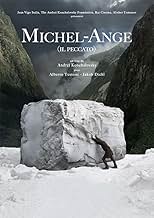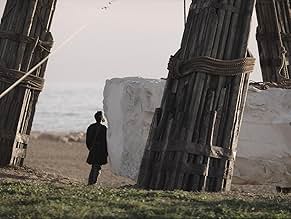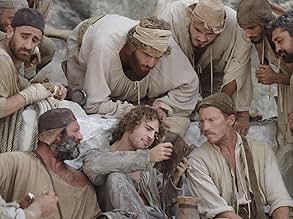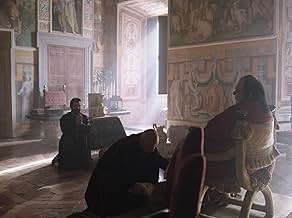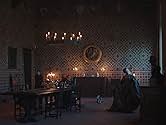VALUTAZIONE IMDb
6,8/10
1457
LA TUA VALUTAZIONE
La vita di Michelangelo Buonarroti.La vita di Michelangelo Buonarroti.La vita di Michelangelo Buonarroti.
- Regia
- Sceneggiatura
- Star
- Premi
- 3 vittorie e 2 candidature totali
Recensioni in evidenza
Watching this film you might wonder "What on Earth this has to do with Michelangelo, except for the decorations?"
While it is a good idea to try a character and period study, rather than a glamorous Hollywood-style biopic, this film is a blank shot at it. On the one hand the cast is interesting, the non-professional actors play well (though such cast would fit better Boccaccio's "Decameron"). The film overall slightly reminds films by Fellini or Milos Forman's "Amadeus" - where there are many grotesque moments, the main character could be almost a caricature but Forman unlike Konchalovsky manages very well the contrast between comical and tragic. In the "Sin" the grotesque is purposeless, because the script is very weak, the storytelling is not engaging and the main character never steps out from the void of half-craziness. In Forman's film Mozart could look dumb, but as soon as music started he turned into a genius. Konchalovsky's Michelangelo only counts coins, argues contracts and purchases marble. He never touches a chisel or brush, he is never shown as a thinker or a poet. There is no moment to sympathize with him or understand why such person could create great art. It is an empty caricature rather than a human.
To sum up, this film is an unfortunately waste of promising actors and excellent Tuscan scenery. Some snapshots are well done because the cast and the decorations are good. But overall you will not gain much by watching this half-baked production, unless you are interested in evolution of Konchalovsky as a director.
While it is a good idea to try a character and period study, rather than a glamorous Hollywood-style biopic, this film is a blank shot at it. On the one hand the cast is interesting, the non-professional actors play well (though such cast would fit better Boccaccio's "Decameron"). The film overall slightly reminds films by Fellini or Milos Forman's "Amadeus" - where there are many grotesque moments, the main character could be almost a caricature but Forman unlike Konchalovsky manages very well the contrast between comical and tragic. In the "Sin" the grotesque is purposeless, because the script is very weak, the storytelling is not engaging and the main character never steps out from the void of half-craziness. In Forman's film Mozart could look dumb, but as soon as music started he turned into a genius. Konchalovsky's Michelangelo only counts coins, argues contracts and purchases marble. He never touches a chisel or brush, he is never shown as a thinker or a poet. There is no moment to sympathize with him or understand why such person could create great art. It is an empty caricature rather than a human.
To sum up, this film is an unfortunately waste of promising actors and excellent Tuscan scenery. Some snapshots are well done because the cast and the decorations are good. But overall you will not gain much by watching this half-baked production, unless you are interested in evolution of Konchalovsky as a director.
10whotheff
Instead of being 24 pictures per second, this movie is 24 paintings per second. Contrary to modern cinema camera is very still. Instead of boring, static actors, we have static frames with a lot of movement in them with perfect angles for every single shot. It was so full of atmosphere, 100% realism and natural sounds that I did not blink for two hours. But instead of being some fancy art film, it tells a story which is very passionate, moving, dynamic. The protagonist lives through heaven and hell in following hos passion and this is so natural and real, that combined with the perfect atmosphere and realism, it made me feel as if I was there with him. And I've seen quite a lot of movies and hard to impress. Every scene, every inch of the screen, every sound, every second has meaning. Even quiet, still shots are felt so heavy, that there is no doubt you would feel them too.
The feeling of the age is so true, everything is so analog. As if no computer was used in the making of this film. I can only imagine the tons of hard work put into it to create this realism. Now I want to see more of Konchalovsky!
The feeling of the age is so true, everything is so analog. As if no computer was used in the making of this film. I can only imagine the tons of hard work put into it to create this realism. Now I want to see more of Konchalovsky!
I found watching Il Peccato / Sin (2019) a delight!
Some user reviews of this film express their disappointment in the fact that you don't see the great master in action, working on marble or drawing. But I see that differently. Being trained as an art historian, I recognized the events and characteristics of Michelangelo shown in this film from the historical documents that have survived from that time. Having spent a significant amount of time studying the subject before making the film, I believe Konchalovskiy in particular closely read Giorgio Vasari's Lives of the Most Excellent Painters, Sculptors, and Architects (1550/1568), a contemporary collection of biographies of Renaissance artists (in the case of Michelangelo, Vasari knew him personally), as the major themes in the film correspond with Vasari's account of this episode in Michelangelo's long life.
Echoing his early masterpiece Andrey Roublev (1966), which he made together with Andrei Tarkovsky, Il Peccato shows how artists are subjects of the time they live in, dependent on power structures and turbulences in violence and prosperity. The film gives a good insight in Michelangelo's social interactions with his family, rivalling artists, and patrons. Moreover, the cinematography is impressive, and the largely unprofessional acting crew performed overall very strong. A great addition to the genre of movies about artists, much more nuanced and intelligent than the classic The Agony and the Ectasy (1965). Hopefully, Michelangelo's rival Leonardo da Vinci will get a biopic of comparable quality soon!
Some user reviews of this film express their disappointment in the fact that you don't see the great master in action, working on marble or drawing. But I see that differently. Being trained as an art historian, I recognized the events and characteristics of Michelangelo shown in this film from the historical documents that have survived from that time. Having spent a significant amount of time studying the subject before making the film, I believe Konchalovskiy in particular closely read Giorgio Vasari's Lives of the Most Excellent Painters, Sculptors, and Architects (1550/1568), a contemporary collection of biographies of Renaissance artists (in the case of Michelangelo, Vasari knew him personally), as the major themes in the film correspond with Vasari's account of this episode in Michelangelo's long life.
Echoing his early masterpiece Andrey Roublev (1966), which he made together with Andrei Tarkovsky, Il Peccato shows how artists are subjects of the time they live in, dependent on power structures and turbulences in violence and prosperity. The film gives a good insight in Michelangelo's social interactions with his family, rivalling artists, and patrons. Moreover, the cinematography is impressive, and the largely unprofessional acting crew performed overall very strong. A great addition to the genre of movies about artists, much more nuanced and intelligent than the classic The Agony and the Ectasy (1965). Hopefully, Michelangelo's rival Leonardo da Vinci will get a biopic of comparable quality soon!
This movie has left me without blinking during the more than two hours it lasts. With beautiful photography, a hard and dry plot, and hypnotic images for its approach to an Italian Renaissance as it must have been in reality, dirty, poor and tremendously unfair.
The actors seem sculpted against the beautiful background of Tuscany with the same rawness that we find in Pasolini's films. We must not forget that Konchalovskiy collaborated with Tarkovsky in the birth of the story of another tormented artist, 'Andrei Rublev', one of his masterpieces.
From the beginning of the film we see Michelangelo in his maturity, when the intense and fierce compulsion of his sculptural works, which seem to relax only in his 'Pieta', are those of a man pursued by 'the devil' -as his character says-, obsessed by money, in a purely masculine world, far from femininity, compassion and subtlety.
The central scene of 'Il Peccato' has been compared to a certain scene in the movie 'Fitzcarraldo' and they are not wrong, because there is dementia linked to the search for a goal that constantly escapes, no matter how much effort is made, and all this is told in a way that takes your breath away. Although it is not a drama, it is the life of someone at the limit of his strength.
Highly recommended.
The actors seem sculpted against the beautiful background of Tuscany with the same rawness that we find in Pasolini's films. We must not forget that Konchalovskiy collaborated with Tarkovsky in the birth of the story of another tormented artist, 'Andrei Rublev', one of his masterpieces.
From the beginning of the film we see Michelangelo in his maturity, when the intense and fierce compulsion of his sculptural works, which seem to relax only in his 'Pieta', are those of a man pursued by 'the devil' -as his character says-, obsessed by money, in a purely masculine world, far from femininity, compassion and subtlety.
The central scene of 'Il Peccato' has been compared to a certain scene in the movie 'Fitzcarraldo' and they are not wrong, because there is dementia linked to the search for a goal that constantly escapes, no matter how much effort is made, and all this is told in a way that takes your breath away. Although it is not a drama, it is the life of someone at the limit of his strength.
Highly recommended.
Nice work with beautiful scenes recreating the atmosphere of those times perfectly well.
Michaelangelo was a genius sculptor and each of his creations move the soul even of modern people, lots of whom have hardly any taste of art at all. This film is artistic enough, beautiful and talented, made by a very professional director of soviet school. Just the right background to tell a story of a genius.
No soundtrack can also mean no noise pollution. I enjoyed everything about this movie
Lo sapevi?
- QuizShot entirely in Italy. The movie was shot in Rome and its environs and in Tuscany, including at the Carrara quarry where Michelangelo got his marble.
- Citazioni
Michelangelo Buonarroti: Money always rubs elbows with infamy.
- ConnessioniReferenced in Večernij Urgant: Andrei Konchalovsky/Pompeya (2019)
I più visti
Accedi per valutare e creare un elenco di titoli salvati per ottenere consigli personalizzati
- How long is Sin?Powered by Alexa
Dettagli
Botteghino
- Budget
- 15.000.000 € (previsto)
- Lordo in tutto il mondo
- 243.043 USD
- Tempo di esecuzione2 ore 14 minuti
- Colore
- Proporzioni
- 1.33 : 1
Contribuisci a questa pagina
Suggerisci una modifica o aggiungi i contenuti mancanti

Divario superiore
By what name was Il peccato - Il furore di Michelangelo (2019) officially released in India in English?
Rispondi
![Guarda Trailer [OV]](https://m.media-amazon.com/images/M/MV5BYThkZDVkMGQtNGZiYS00NzMwLWFkOWUtYTFhYThiN2E4MTQwXkEyXkFqcGdeQXRyYW5zY29kZS13b3JrZmxvdw@@._V1_QL75_UX500_CR0)
